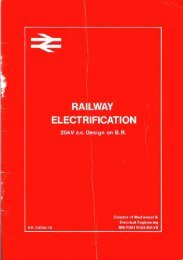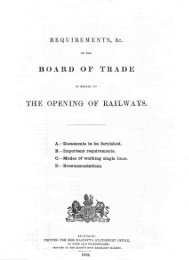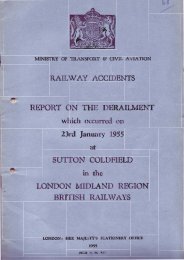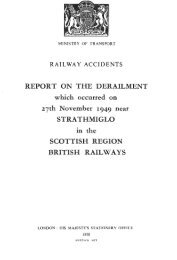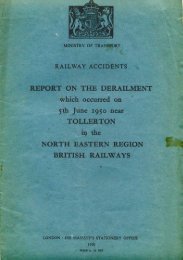R A I LT R AC K - The Railways Archive
R A I LT R AC K - The Railways Archive
R A I LT R AC K - The Railways Archive
Create successful ePaper yourself
Turn your PDF publications into a flip-book with our unique Google optimized e-Paper software.
ecomes due for total renewal at the same time, thus<br />
increasing the opportunities to use TCS technology.<br />
<strong>The</strong> TCS will be inappropriate for many high-capacity<br />
suburban routes where very large train fleets operate, due<br />
to the costs of fitting rolling stock with the necessary<br />
equipment.In these cases,conventional colour-light signalling<br />
remains the best option.However, there are still significant<br />
opportunities to improve the cost-effectiveness and<br />
performance of this type of signalling,and to extend its use<br />
to parts of the network previously served by traditional<br />
mechanical installations.We are achieving this by introducing<br />
systems and equipment in use on other railways where they<br />
have a proven track record.<br />
Network Management Centres (NMCs) will provide<br />
the tools and environment for every activity associated with<br />
the delivery of train paths,from timetable planning,to setting<br />
routes and clearing signals,to real-time management of<br />
incidents and the gathering of performance data.We have<br />
reviewed our strategy for the construction of NMCs,and<br />
have concluded that they are most attractive when a large<br />
area of railway requires renewal at once, for example a<br />
route modernisation. We are evaluating the options for their<br />
further deployment across the network.<br />
Modern axle-counters are an extremely reliable and<br />
economical means of providing train detection.<strong>The</strong>y can be<br />
applied on a diverse range of routes from high-speed,high-<br />
density through to rural lines.We are proposing to introduce<br />
new axle-counter systems during 1999 at a number of<br />
locations.<br />
We are also introducing small computer-based control<br />
systems which will enable us to renew secondary route<br />
signalling and level crossings at lower cost than with our<br />
established technologies.<strong>The</strong> first implementation will be on<br />
the Norwich–Cromer route in 1999.<br />
At the other end of the scale, we are working with our<br />
suppliers on the introduction of high-speed computer-based<br />
systems for the renewal of signalling in large and complex<br />
areas such as our major stations and junctions where the use<br />
of current systems could restrict throughput.<br />
We are also working on our control-centre technology,<br />
to ensure that we have an appropriate set of options for<br />
control in areas which do not justify an NMC.<br />
In summary, our signalling strategy is to:<br />
• implement TCS on main-line routes starting with the<br />
WCML from 2002.Other routes are planned to follow,<br />
but there are many routes for which TCS does not<br />
appear to be economical.<br />
• develop more cost-effective solutions for the renewal of<br />
conventional signalling where TCS is not cost-effective<br />
over the remainder of the network – urban,main-line<br />
and secondary routes.<br />
• ensure that the existing signalling assets are maintained,<br />
and renewed as required.This will generally involve<br />
targeted renewals, rather than renewal of the entire<br />
installation.<br />
Telecoms renewals. Our telecoms strategy is to optimise<br />
whole-life costs while renewing equipment to maximise<br />
reliability and minimise obsolescence and reliance on<br />
bespoke systems.Our strategy is also to ensure that we<br />
derive the maximum benefit from the commercial<br />
liberalisation of telecoms services.<br />
We are using the opportunity of the forthcoming<br />
expiry of the leases for many of our long-distance cable<br />
routes to create new telecoms services and improve<br />
reliability of equipment.A trial of such equipment will take<br />
place this year on the Brighton–Havant route.<br />
<strong>The</strong> coming year will also see the introduction of new<br />
proprietary operational telephone systems at Ashford,<br />
Birmingham,Leicester, London Bridge, Swindon,London<br />
Victoria and Walsall.<br />
We are introducing<br />
computer-based<br />
control systems<br />
to renew secondary<br />
route signalling and<br />
level crossings at<br />
lower cost than with<br />
our established<br />
technologies<br />
39



